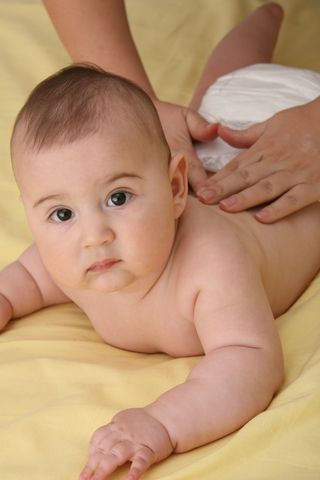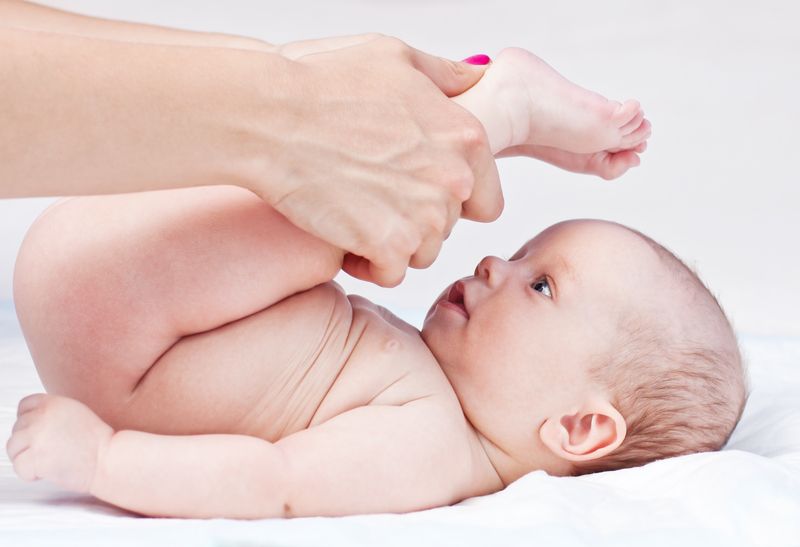The Baby Massage Guide - Special Techniques Explained
The basic idea though, is that you gently knead, stroke or rub the muscles and soft tissue on each part of a baby's body. By doing this, you help your baby relax, heal and bond with you (and vice versa!).

Quick links
- The benefits of massaging your baby
- The benefits of baby massage for parents/caregivers
- What you need to massage your baby
- When to massage your baby
- Using essential oils for baby massage
- Baby massage techniques
- Baby massage strokes
Baby massage has been practiced throughout the ages and in many countries, especially in Asia and Africa. Only in recent years has the western world taken notice and started implementing this.
There are many different techniques in massage therapy, and the same goes for baby massage.
The basic idea is to gently knead, stroke, or rub the muscles and soft tissue on each part of a baby's body. Doing this, you help your baby relax, heal and bond with you.
While massaging your baby, keep eye contact and gently talk or sing to your baby; this should be an enjoyable time for both of you! When you feel calm and relaxed, your baby will relax too. If your baby gets irritated or restless, you can stop and try some other time again.
Baby massage should be a pleasant experience, do not allow it to become just another chore in your baby care routine.
Also, learn more about the benefits of skin-to-skin contact and kangaroo mother care.

The Benefits of Infant Massage
- Constipation relief by regulating the digestive system.
- Helps relieve asthma symptoms.
- Improves blood and lymph circulation.
- Improves sensory awareness. It improves motor skills & overall body awareness.
- Reduces symptoms of conditions like eczema.
- It enhances the growth of muscles and improves muscle tone.
- It will boost your baby's immune system.
- It promotes relaxation. Because massage increases oxytocin and prolactin levels, stress levels decrease.
- Increases neurological development. It also stimulates the brain and nervous system with new experiences, which helps the baby to understand movement and social behavior.
- Touch benefits like bonding and attachment between parents and child.
- Enhances a baby's sense of love and trust.
- Improves self-esteem, body image, and social functioning.
- Helps your baby sleep more soundly and for more extended periods.
- It's a way of communicating.
- It aids in healing.
- It improves suppleness.
- Provides all-important skin stimulation. Why is touch important?
- It relieves discomfort like gas, colic, teething, congestion (stuffy chest and nose), etc.

Benefits for Parents/Caregivers
- It improves communication by helping you to understand and respond to your baby's non-verbal cues.
- Because it is so relaxing and reduces your blood pressure and heart rate.
- It would ease your stress if you were separated from your baby during the day.
- It gives you a feeling of competence and confidence in caring for your baby.
- It increases prolactin and oxytocin, which is very important for a breastfeeding mother; this can increase the flow and volume of your breast milk.
- Increases your ability to help your child relax in times of stress, both now and in the future.
- It increases your overall sense of health and well-being.
- It can also help decrease Postpartum Depression symptoms in mothers who suffer from it.
- Teenage mothers bond and interact better with their babies when they give regular massages.
As you can see, massaging your baby is good for the baby and you too!
What You Need for Baby Massage
- Make sure that the room is comfortably warm and not too brightly lit. Create a relaxing atmosphere for you and your baby. You can put on some soft music.
- Place your baby on a flat surface, such as the changing table, or sit on the floor or bed. Both of you should be comfortable and safe. Ensure your baby won't fall off the changing table or bed if they make any sudden movements.
- Cover the surface with a towel or cloth in case your baby decides to make a wee or poo so that you can quickly clean up the mess. You can also keep your baby's nappy on if you prefer.
- I used baby lotion to massage my children. The main idea is to reduce friction between your hands and your baby's skin, helping you glide over your baby easily and in a continuous motion.
- Test the oil on a small skin patch first to ensure your baby is not allergic.
- Some people like to add essential oils to these carrier oils; others prefer not to. Although it might add a lovely scent and provide other benefits, it does take away from the bonding experience. When the oil's aroma is neutral (such as vegetable and plant oils), the baby gets to know your scent better. It adds to the bonding process; this is a personal choice.
- Ideally, you should get proper training from an infant massage instructor, who will teach you the correct baby massage techniques.
When to Massage Your Baby
- If your baby is sick or has a fever, diarrhea, or skin rash, it is better to skip the massage. Unless, of course, your doctor recommends otherwise.
- To prevent your baby from bringing up their milk, do not massage your baby directly after a feed.
- Also, ensure that your baby is in a good mood and ready to be massaged. If your baby is calm, content, and has a steady gaze and relaxed limbs (or reaches out to you after telling your baby it's time for a massage), you know they are ready.
- If your baby turns away, becomes stiff and fussy, or is crying, it is better to wait until they calm down before trying again.
- The time of day that you massage your baby is entirely up to you. Some prefer mornings; others make it part of the bathtime routine or bedtime routine; this might change with time as your baby grows up. If your baby becomes too excited during a massage, move the massage sessions to the daytime.
- Do not overtire your baby. Short sessions of massage go a long way.
Your massage routine will be as unique as you and your baby!

Tushbaby Hip Carrier
With its ergonomic design and comfortable waistband, Tushbaby provides optimal support for both you and your baby, allowing for bonding on the go. Say goodbye to shoulder and back pain from traditional carriers, as Tushbaby evenly distributes your baby's weight, relieving strain and promoting better posture.
When Using Essential Oils
With baby oil massage, it's best to use oil that is natural and non-scented for the first couple of weeks. Experts recommend you use oil that is edible and odorless.
Remember that your baby will put their hands in their mouth; therefore, use natural carrier oils, such as olive oil, baby oil, pure sweet almond oil, or sesame seed oil.
Baby massage oils that are mineral-based may be suitable for waterproofing but may clog the pores.
After a few months, you can introduce different scented oils to stimulate your baby's olfactory system.
The following essential oils could be added to your carrier oils mentioned above. Only a few drops of the following are added to the carrier oils:
- Mandarin essential oil is a calming massage oil. It can help with your baby's mood and will help your infant sleep peacefully.
- Chamomile essential oil calms skin rashes and any skin irritation. This oil also creates a sense of tranquility.
- Neroli oil increases circulation throughout the body and reduces fear and worry.
Buy an already mixed oil for baby massage. This oil was created with sensitive skin in mind. It is made with lavender and chamomile, which can be massaged onto a baby’s skin to help relax and prepare your baby for a nap or bedtime.
Massage Techniques
Baby massage is like learning to play the piano (or any other instrument, for that matter).
You can read up all you want about the instrument and get all the theoretical music knowledge. If you don't physically practice playing the instrument, preferably every day, that head knowledge alone won't be useful to you. Knowing and doing are two different things.
The same applies to massaging your baby and learning many baby massage techniques. So with that in mind, I decided to place some videos here to give you an idea of what baby massage looks like.
BUT...
I strongly recommend finding an infant massage instructor who can teach you the correct techniques in person and help you "practice" them. It's one of the best investments (referring both to time and money) that you'll make.
Milking or Effleurage Movements
Effleurage massage entails long-stroke movements, which you usually do with a flat hand or fingers.
The "milking" technique is done while holding the baby's leg (as shown in the video below), and then you move your hands together in opposite directions, squeezing lightly.
Infant Massage Basics
Baby Massage Tips & Getting Started
Massaging Baby's Legs
Massaging Baby's Tummy
Massaging Baby's Arms
Massaging Baby's Back
Massage Strokes
The following is especially helpful for babies with colic symptoms:
- Rub in a circular clockwise direction. Babies with colic usually benefit from having their legs and tummies rubbed.
- Wringing motions are extra stimulating and bring blood to the skin's surface.
- Milking or effleurage movements have a calming, relaxing effect.
- Try different pressures, speeds, and numbers of strokes.
Important Note: You do not want to use a light touch, as this will feel more like tickling and will have the opposite effect than what you want to accomplish. Gentle but deep pressure stimulates both tactile and pressure receptors.
